
Your guide to cat meowing and other vocalisations

Lucy Hoile
8 November 2023
If you love a good natter with your favourite feline and would love to know what they’re trying to communicate, this one’s for you!
Below, expert cat behaviourist Lucy Hoile delves into the world of feline vocalisation. Discover why your cat meows at you, whether they talk to other cats, and what all of that chatter means.
- Why do cats meow?
> Do cats meow at each other? - Why do cats meow at humans?
> How do I manage excessive meowing? - Types of cat vocalisation and what they mean
- Other questions about cat meowing
> Why is my female cat meowing so loudly?
> Why doesn’t my cat meow?
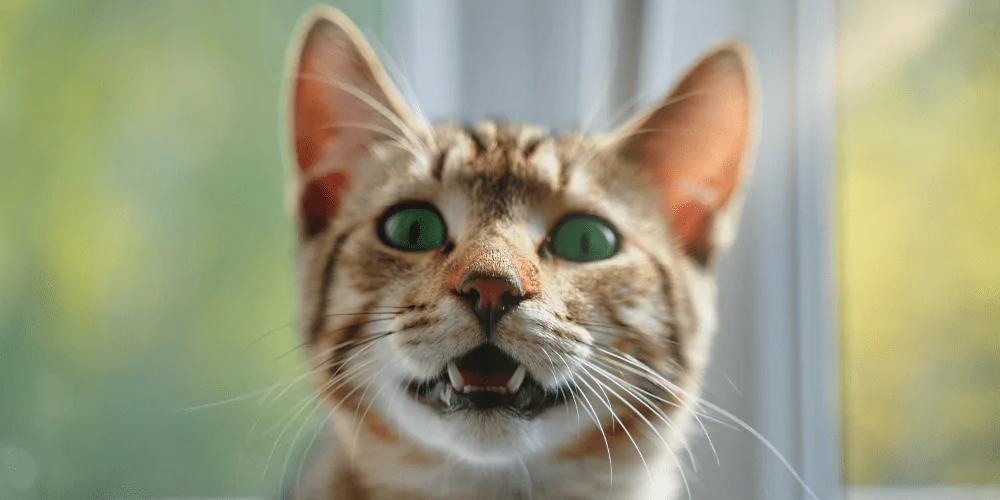
Why do cats meow?
You may be surprised to learn that the cute little ‘meows’ don’t appear to have a purpose between cats. It’s we humans that have given it meaning as a form of communication with our felines.
On the other hand, other types of cat vocalisations do have a purpose – but more on that later.
Some cats can be more prone to being vocal than others, including:
- Breeds like Siamese and Bengals
- Those living with people (as opposed to free-living cats who don’t come into contact with as many humans)
- If they’re in pain or feeling anxious or frustrated
> Do cats meow at each other?
It’s not very common for cats to meow at each other. Instead, they tend to communicate with each other using other forms of vocalisation.
The only exception to this are kittens mewing back and forth with their mum:
- Kittens are born with their eyes closed, meaning it’s easy for them to get lost if they stray from the nest. They will mew to their mum to let them know they can’t find their way back.
- Kittens will also purr while having their milk to let mum know they’re happy, and mum purrs back to let them know they’re safe.
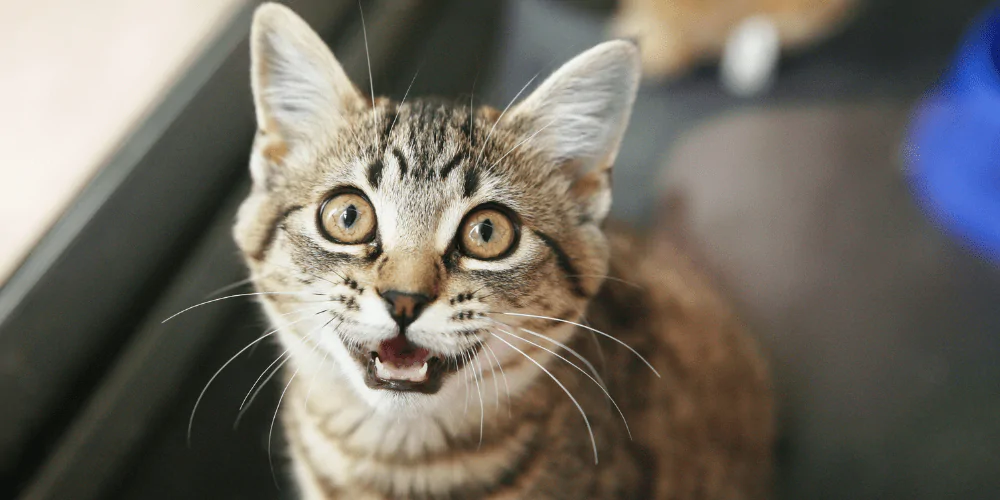
Why do cats meow at humans?
Some people think cats meowing at their humans has carried over from kittenhood. They see us as their carers and so meow as they did with their mum.
For many cat parents, meowing is a positive interaction.
Getting their way
The main reason cats meow at us is because they want something, which we reinforce and then turn into a learned behaviour.
Cats will often meow incessantly at difficult times such as late at night or first thing in the morning. So be very careful how you respond to meowing. Cats soon catch on that when they want food, playtime, petting, or access to somewhere, meowing can get it for them.
Frustration
Your cat may start meowing out of frustration and impatience. For example, if you’re getting food ready and they think it’s taking too long.
But this behaviour can still be rewarded if you give them their food while they’re still meowing.
Showing signs of pain
Some telltale signs that your cat may be meowing out of pain include:
- Meowing that has started suddenly and unexpectedly
- Being less active
- An increase in reactivity or aggressive behaviour
- Discomfort with being handled
- Changes in appetite
- Excessive grooming (especially around the stomach as cats are prone to UTIs and kidney problems)
- Squinting eyes for long periods
- Ears turned back
Always speak with a vet if you think your pet may be poorly and in pain.
Cognitive dysfunction
Cats can suffer from cognitive dysfunction – similar to human dementia – which can cause excessive meowing. The meowing is usually unexpected and comes out of nowhere, or happens when your cat is alone.
There are usually other behaviours that follow this such as confusion, disorientation, becoming more/less sociable, and changes in activity patterns. Always speak to your vet if you’re worried.
Anxiety
An anxious cat can make their worries heard by meowing. This tends to happen when no one is around. It may be dark and quiet and your cat doesn’t have any reassurance.
Get in touch with a qualified cat behaviourist if you’re concerned that your cat may be stressed or anxious.
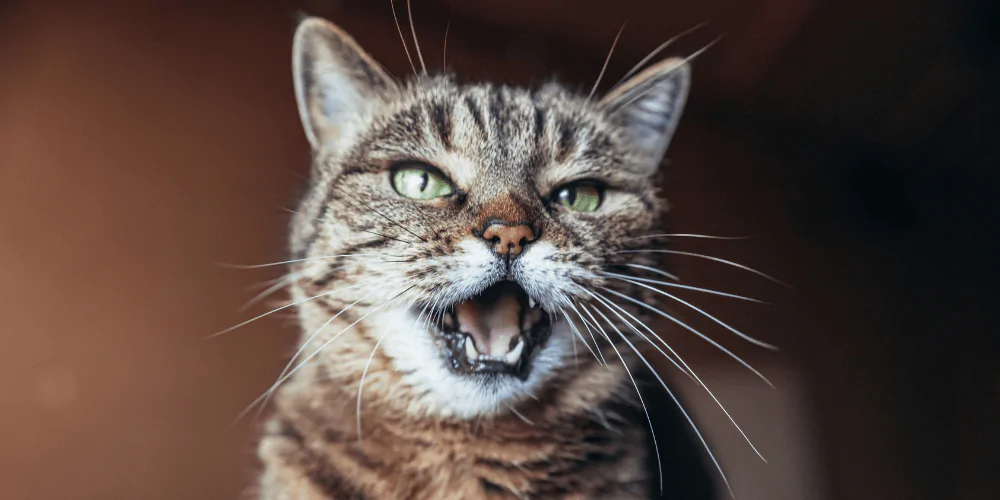
> How do I manage excessive meowing?
Demanding food
If your cat is meowing to demand food from you, there are a few options available:
- Try free feeding your feline. This is where they always have dry food available, so they’re in control of their meals. Free-living cats hunt all day and sleep between lots of little meals, so it’s not natural for cats to only eat once or twice a day. Keep an eye on your cat’s weight as if they are prone to eating too much – this may not be an option for you.
- Split your cat’s normal portions into smaller meals more frequently throughout the day. This can help to avoid frustration and difficult behaviour around meal times.
- Stick to a consistent feeding plan – and don’t budge from this – if you want to feed your cat at specific times. As soon as you get lenient with timings, your cat will learn it can ask for food earlier.
- Try an automatic feeder. These can be set to release food at specific times of the day, which can help if your cat is waking you up at awkward hours.
Attention seeking
For non-anxious cats, meowing throughout the night is normally a form of attention-seeking behaviour. To manage this, make sure interactions with your cat are on your terms.
- So if you’re in bed, don’t get up and go to them while they’re meowing as this is reinforcing the behaviour.
- Another example is meowing at the door. If your cat is asking to come in, wait for a bit of quiet before you give them access or you’ll again be directly rewarding the behaviour. You may need to protect your carpets first in case your cat tries to scratch at the door as well as meow.
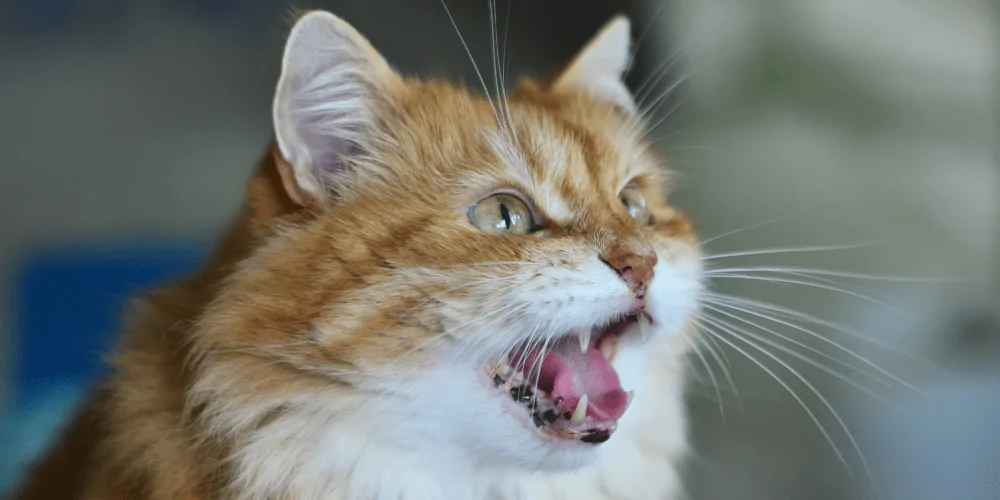
Types of cat vocalisation and what they mean
Your cat has an impressive range of vocalisations beyond the well-known meow. They use them to share how they’re feeling and what they think about other people or animals.
Purring
- Purring is usually a happy noise that says your cat is feeling content. It’s also a reassuring sound that comes from the days of being a kitten and comforted by mum.
- Cats will purr if they enjoy being stroked as the movement replicates being washed by mum.
- Purring can also appear with kneading behaviour as this is what they did to mum’s stomach to stimulate milk flow.
- Cats may use purring in the same way as meowing to get something from you, called a solicitation purr. It’s more of a high-pitched purring rather than a low, quiet, content purr. It’s also accompanied by attention-seeking behaviours like pacing around food bowls and walking over the desk while you work.
- It’s important to know that cats may also purr when in pain. The frequency of the purring can be self-soothing and a form of pain relief.
Chirruping and chattering
- A chirrup or trill is normally a happy greeting behaviour that can be directed at people or other cats.
- Chattering seems to be a longing/wistful behaviour and usually appears when cats want something they can’t have, like a bird.
- Cats may chatter while sitting at the window, at the bottom of a tree, or below a birdbath as a few examples.
Hissing
- Hissing can be directed at anyone including people, other cats, dogs, objects, and unpleasant smells.
- Many people think hissing is a sign that their cat is angry and will attack. But it’s actually your cat’s way of telling you they need space and for the distressing object to back away.
- Hissing that appears during playtime is a sign that your cat has had enough. So always use it to gauge if they’re happy to keep playing. And remember that many cats don’t like roughhousing.
Growling
- Growling and low rumbling is quite a serious sign that your cat isn’t happy.
- It’s quite common for cats to growl at each other as they’re easily uncomfortable around strange felines.
- Some cats will growl if they’ve been hunting and have something in their mouth that they worry will be taken off them. This behaviour can transfer across to toys.
- Growling is another warning from your cat to back away from them and aggression can follow if ignored.
Yowling
- Yowling is a more intense sound that’s a mixture of a growl and a meow.
- It tends to happen more often between cats – you might hear it outside at night when cats are having a showdown.
- Yowling is a sign that aggressive behaviour is close and almost inevitable.
- If cats are yowling at each other, you’ll see obvious signs of a fight starting. This includes staring at each other, one cat being defensive and the other offensive or both being offensive.
- If one cat is yowling at another, the other cat may move in slow motion to sneak away in order to avoid a fight.
Caterwauling
- Caterwauling is a panicked meowing sound that shows your cat is in a serious situation.
- This tends to be used during an attack and is a clear sign that your cat is in panic mode. There’s a risk they may be injured trying to get out of the situation.
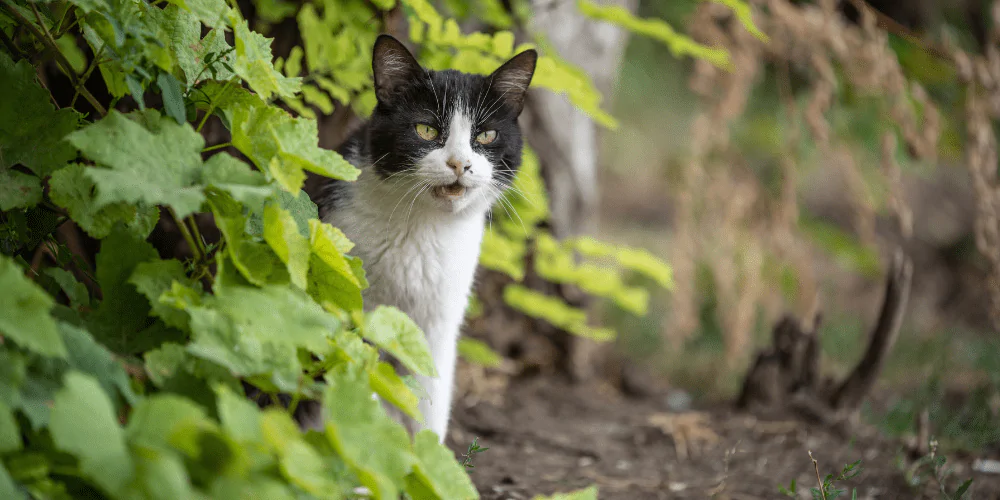
Other questions about cat meowing
> Why is my female cat meowing so loudly?
Are there times when your female cat is really putting some oomph behind those meows? If she’s not yet been neutered, chances are she’s probably in heat!
You’ll know these are in heat meowing calls because:
- They’re frequent as well as very loud, long, and drawn-out
- They’ll happen alongside other changes such as affection rubbing, pacing, restlessness
- Your cat will be presenting – belly on the ground with her back up and tail to the side
> Why doesn’t my cat meow?
There’s no physical reason why a cat can’t meow and there aren’t any breeds which are known to be quieter than others.
Like us, all cats are individuals. So it could just be down to the uniqueness of your feline that they simply don’t meow.
Give your chatty cat comprehensive cover for all of life’s adventures with flexible cat insurance from Petsure.


